Harun Farocki systematically draws our attention to the way in which images, technologies, and systems of representation define social and political space, consciousness, subjectivities, structures of feeling, and ideologies.
In this new work, Farocki juxtaposes the history of computer-based animation with elements of art history. In only thirty years, computer-generated images and animations have evolved from simple symbolic forms into images that aspire to perfect simulation, and seem to desire to outperform cinematographic and photographic representations, not merely of “static” reality, but increasingly of the dynamic aspects of life, as manifest in gestures or complex movement in general. In appropriating the dynamics of social and natural reality, does computer-generated hyperrealism seek to outdo reality itself?
Today, mimesis has become a matter of generative algorithms, and the resulting technologies are increasingly capable of calculating, predicting, and controlling complex processes—from manufacturing, to war, to emotional experiences in the animated worlds of mass entertainment. Underlying Farocki’s investigation into the frontiers of innovation in current image-technologies is the assumption that increasingly, we live in technologically produced image-worlds in which images have become what he calls “ideal-typical.” In the new mimetic paradigm of digital “realism”, reality is no longer the measure of the always imperfect image; instead, the virtual image increasingly becomes the measure of an always-imperfect actuality. With the “ideal-typical” image, representation seeks to overcome lived reality by constructing, monitoring, and governing it. Even fantasy and fiction now tend to assume a predictive and even preventive quality. Does this leave actual, lived reality to exist only as derivation of the ideal, as flaw or impurity, or, like in military or surveillance technologies, as a potential threat? Have these ideal-types become our new normative schemes, all-encompassing idols capable of scripting and predicting all actual life-movement?
One more time, Parallel questions the notion of “progress” that underlies histories of art and representation based on a linear, evolutionary progression from imperfect representation (mimesis) to more accurate, complex, and perfect forms. Parallel is like an interrogation of possible other stories, evolutions, or reverse-evolutions of which the image-surfaces of digital animation and their underlying generative algorithms speak.
Harun Farocki, born 1944 in German-annexed Czecho- slovakia, lives and works in Berlin

